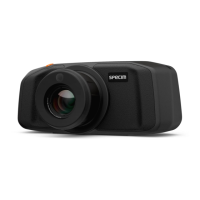| Introducing the Specim IQ Imaging System | 6
Figure 3: Three Color Channels
• In the wavelength range of 400-700 nm
When we take a spectral photograph, we gain wavelength information from each recorded pixel:
• Through up to hundreds of color channels
Figure 4: Hundreds of Color Channels
• In the wavelength range of 200-12 000 nm
Using hyperspectral imaging, we can create a much richer image of the reality than just a normal photograph.
What can we, then, do with the richer image of the reality? Since we know that each material reflects light in a
different way, we can detect different materials from the spectral photographs. And not only materials, but also the
amount of materials and materials in different conditions.
For example, if we see a conventional photograph of an apple, we recognize that it is an apple, but we cannot exactly
tell how ripe that apple actually is. With spectral imaging, we can, because the color of a ripe apple differs slightly
from that of a raw apple.
When dealing with extremely small differences in the reflected light wavelengths, we cannot rely on our eyes to
tell the differences that cause the wavelength variation in each photographed target. In the apple example, we need
information on the exact wavelengths that are reflected from the apple during its different stages toward ripeness.
These sets of spectral reflectance information are called spectral libraries.
From a more technical perspective, it is not only the reflected wavelengths in the spectral photograph that indicate
the existence or non-existence of a particular material in the photographed target. Often, it is necessary to use various
calculation models to dig even deeper into the characteristics of the target. These calculation models, for their part, are
called spectral processing models.
To make things even easier for the user, we can combine spectral libraries with spectral processing models to create
specific spectral imaging applications for specific purposes. For example, we can create an application for telling
the ripeness of an apple, or an application for mapping wheat fields to locate areas that need more fertilizers. The
foreseeable use cases for these applications are virtually infinite.

